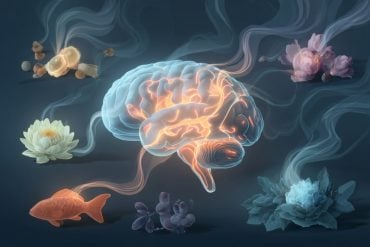Summary: A newly discovered neural circuit in the thalamus prevented reward-seeking behaviors when activated in a preclinical model. When blocked, this circuit increases high-risk reward-seeking behaviors. The findings could lead to new therapies for addiction and other disorders associated with high-risk reward-seeking behaviors.
Source: Medical University of South Carolina
A team of researchers in the College of Medicine at the Medical University of South Carolina (MUSC) has discovered a brain circuit that inhibits motivated behaviors.
They report in Nature Communications that the circuit is located in a region of the brain called the thalamus.
When active, it can prevent reward-seeking behavior in a preclinical model. In the same model, blocking, or inhibiting, the circuit leads to reward seeking even in high-risk contexts. Importantly, administering opioids causes immediate and significant disruption of the circuit, resulting in even riskier behaviors.
The findings from this study address an understudied area of addiction research and emphasize a new perspective for studying and treating addiction.
Behavior can be thought of as a car moving through an intersection after stopping at a traffic light. For the car to move forward, the brake must be released, and the gas pedal must be pressed.
In the past, addiction research has largely focused on the gas pedal, identifying brain regions and circuits that promote reward-seeking behavior in hazardous contexts. However, this approach fails to address a major component of addiction – the inability to stop risky behavior from happening in the first place.
Researchers at MUSC recognized the importance of identifying these behavior-braking circuits and wanted to know why they were faulty in addiction.
“We stop ourselves from behaving inappropriately or making risky decisions every day,” said James Otis, Ph.D., assistant professor in the Department of Neuroscience at MUSC and senior author of the study. “We need to understand how existing circuits that normally stop risky behaviors become tweaked so that they’re less effective.”
To find a potential brake circuit, the researchers focused on a region of the brain called the thalamus, which is known to integrate environmental and internal information that guides feeding and reward seeking.
They examined brain activity in a preclinical model of reward-seeking behavior using an advanced imaging method called two-photon microscopy. This cutting-edge technique allowed the team to identify individual brain cells that were inhibited during reward seeking, much like a brake that must be released to drive forward.
The researchers were then able to generate a circuit map thousands of times more precise than could have been achieved with standard imaging methods like MRI. When they artificially inhibited the circuit, they found that reward-seeking behavior continued even in simulated high-risk situations that would normally prevent the behavior from happening. The researchers had found their brake.
To address what could lead to a faulty brake system in the context of addiction, the team asked whether commonly abused drugs, such as opioids, could interfere with the circuit’s function.
“We’ve known for a long time that opioid use and use of other drugs strongly affect a human’s ability to say no, to not perform risky actions,” said Otis. “After we found out that this circuit is really important for suppressing risky behaviors, we wondered if heroin, an opioid and common drug of abuse, could shut it down and induce a risky decision. And we found that that’s absolutely the case.”

While the researchers expected to find that opioids had an effect on the circuit in some form or another, the magnitude of the effect that they discovered was surprising.
“What was really interesting to me was that just one heroin injection could immediately lead to riskier decisions. We found that it’s because heroin binds directly to opioid receptors in the circuit and shuts down this brake,” said Otis.
Moving forward, the researchers aim to determine whether this finding holds true for other substances of abuse, such as alcohol. They are also conducting studies to determine why certain brain cells respond differently in the presence of opioids, with the hope of finding targets for future treatments for addiction.
“We really need therapeutics that target these brain circuits more specifically, rather than mimicking what the drugs of abuse do to a lesser degree,” said Otis. “I think that’s a poor way of treating addiction. And I think most addiction biologists would agree with that.”
Overall, Otis believes that the study’s findings provide both words of warning and hope for the future.
“Using drugs of abuse like heroin can immediately cause risky decisions,” he said. “But by targeting these brain pathways that go offline because of drug use, we may be able to develop improved therapeutics that restore their ability to act as a brake on reckless behavior.”
About this risk-taking and neuroscience research news
Author: Kimberly McGhee
Source: Medical University of South Carolina
Contact: Kimberly McGhee – Medical University of South Carolina
Image: The image is in the public domain
Original Research: Open access.
“An opioid-gated thalamoaccumbal circuit for the suppression of reward seeking in mice” by James Otis et al. Nature Communications
Abstract
An opioid-gated thalamoaccumbal circuit for the suppression of reward seeking in mice
Suppression of dangerous or inappropriate reward-motivated behaviors is critical for survival, whereas therapeutic or recreational opioid use can unleash detrimental behavioral actions and addiction.
Nevertheless, the neuronal systems that suppress maladaptive motivated behaviors remain unclear, and whether opioids disengage those systems is unknown. In a mouse model using two-photon calcium imaging in vivo, we identify paraventricular thalamostriatal neuronal ensembles that are inhibited upon sucrose self-administration and seeking, yet these neurons are tonically active when behavior is suppressed by a fear-provoking predator odor, a pharmacological stressor, or inhibitory learning.
Electrophysiological, optogenetic, and chemogenetic experiments reveal that thalamostriatal neurons innervate accumbal parvalbumin interneurons through synapses enriched with calcium permeable AMPA receptors, and activity within this circuit is necessary and sufficient for the suppression of sucrose seeking regardless of the behavioral suppressor administered.
Furthermore, systemic or intra-accumbal opioid injections rapidly dysregulate thalamostriatal ensemble dynamics, weaken thalamostriatal synaptic innervation of downstream neurons, and unleash reward-seeking behaviors in a manner that is reversed by genetic deletion of thalamic µ-opioid receptors.
Overall, our findings reveal a thalamostriatal to parvalbumin interneuron circuit that is both required for the suppression of reward seeking and rapidly disengaged by opioids.






